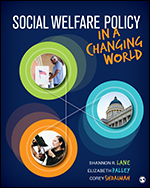Social Welfare Policy in a Changing World
Shannon R. Lane - Yeshiva University, New York, USA
Corey Silberstein Shdaimah - University of Maryland, Baltimore, MD, USA
Elizabeth S. Palley - Adelphi University
Recipient of a 2022 Most Promising New Textbook Award from the Textbook & Academic Authors Association (TAA)
Social Welfare Policy in a Changing World is an approachable and student-friendly text that links policy and practice and employs a critical analytic lens to U.S. social welfare policy. With particular attention to disparities based on class, race/ethnicity, ability, sexual orientation and gender, authors Shannon R. Lane, Elizabeth S. Palley, and Corey S. Shdaimah assess the impact of policies at the micro, meso, and macro levels. The authors provide students with a brief foundation in history, the policy process, and theory, while primarily focusing on helping students recognize the many ways that policy affects their lives and the lives of their clients and communities. Connecting description, theoretical analysis, and advocacy, this new text challenges readers to examine the development, consequences, and future implications of core policies. Students will come away with a newfound understanding of how to use the political process to address social justice issues and enact meaningful policy change.
FREE DIGITAL TOOLS INCLUDED WITH THIS TEXT
SAGE edge gives instructors and students the edge they need to succeed with an array of teaching and learning tools in one easy-to-navigate website. Learn more: edge.sagepub.com/lane
Available formats
See what’s new to this edition by selecting the Features tab on this page. Should you need additional information or have questions regarding the HEOA information provided for this title, including what is new to this edition, please email sageheoa@sagepub.com. Please include your name, contact information, and the name of the title for which you would like more information. For information on the HEOA, please go to http://ed.gov/policy/highered/leg/hea08/index.html.
For assistance with your order: Please email us at textsales@sagepub.com or connect with your SAGE representative.
SAGE
2455 Teller Road
Thousand Oaks, CA 91320
www.sagepub.com
- a password-protected site for complete and protected access to all text-specific instructor resources;
- test banks that provide a diverse range of ready-to-use options that save you time. You can also easily edit any question and/or insert your own personalized questions;
- multimedia content featuring third party videos that meet the learning needs of today’s media-savvy students and bring concepts to life;
- discussion questions and class activities that help students engage with the material by reinforcing important content and inspiring critical thinking;
- sample course syllabi for semester and quarter courses that provide suggested models for structuring your courses;
- editable, chapter-specific PowerPoint® slides that offer complete flexibility for creating a multimedia presentation for your course; and
- lecture notes that summarize key concepts by chapter to help you prepare for lectures and class discussions.
- an open-access site that makes it easy for students to maximize their study time, anywhere, anytime;
- multimedia content featuring third party videos that bring concepts to life;
- eFlashcards that strengthen understanding of key terms and concepts; and
- eQuizzes that allow students to practice and assess how much they’ve learned and where they need to focus their attention; and
- discussion questions and class activities that help students engage with the material by reinforcing important content and inspiring critical thinking.
- Vignettes in each chapter allow instructors and students to see how policies might play out in situated social work practice.
- Exercises for reflection, discussion, and action guide students through the application of key concepts and challenge them to take action, connecting the ideas in the book to their practice.
- Thorough descriptions of U.S. policy context with examples provide foundational information for students who may feel intimidated by the material with comprehensive information to satisfy more experienced students.
- A solid historical foundation for each substantive area helps students understand the context for current policies and how we arrived at them.
- An intentional focus on race, gender, class, and sexual orientation throughout all chapters show the embedded and ubiquitous nature and consequences of discrimination, disparities, and oppression in many facets of social welfare policy.
- While most texts focus on either theoretical analysis or description, a key innovation of this new text is combining the two.

